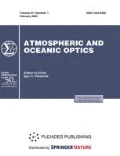Abstract
The areas of forest loss from fires in the Verkhneketsky district of the Tomsk region are considered. Pollutant emissions from fires are calculated. It is found that smoke aerosols from fires in 2012 and 2016 significantly exceed in mass technogenic emissions from stationary sources in the Verkhneketsky district. Based on the CALIOP lidar data, the smoke rise altitudes are determined as 1.3 to 4.3 km, which does not contradict model calculations.





Similar content being viewed by others
REFERENCES
https://sakhaday.ru/news/grinpis-opublikoval-kartu-unichtozhennyh-v-rossii-lesov/. Cited January 28, 2020.
N. M. Debkov and A. S. Opletaev, “Dynamics of the forest cover in the Tomsk region from 2000 to 2014,” Electronic Archive UGLTU. No. 2, 27–35 (2018).
Development strategy of timber and related industries in the Tomsk region for the period until 2020. https://pandia.ru/text/77/407/77615.php. Cited January 28, 2020.
D. T. Milodowski, T. A. Mitchard, and M. Williams, Forest Loss Maps from Regional Satellite Monitoring Systematically Underestimate Deforestation in Two Rapidly Changing Parts of the Amazon. https://apps. webofknowledge.com. Cited January 28, 2020.
Assessing Harvested Sites in a Forested Boreal Mountain Catchment through Global Forest Watch. https:// apps.webofknowledge.com. Cited January 28, 2020.
N. S. Evseeva, Ecological Geomorphology. Hazard Natural Processes (Publishing House of Tomsk Univ., Tomsk, 2017) [in Russian].
M. A. Bizin, S. A. Popova, O. V. Chankina, V. I. Makarov, M. P. Shinkorenko, B. S. Smolyakov, and K. P. Kutsenogii, “The effect of forest fires on mass concentration, disperse and chemical composition of atmospheric aerosols on a regional scale,” Opt. Atmos. Okeana 26 (6), 484–489 (2013).
M. N. Alekseeva, E. A. Golovatskaya, and I. G. Yashchenko, “Air pollution from fires of drained peatlands in Tomsk region,” Opt. Atmos. Okeana 32 (12), 971–977 (2019).
Forest Plan of the Tomsk Region for 2019–2028. https://deples.tomsk.gov.ru/documents/front/view/id/ 11898. Cited January 28, 2020.
Loss in Forests in Verkhneketskii District. www.globalforestwatch.org/map/6/53.35/110.15/ALL/grayscale/ loss,forestgain,forest2000?tab=analysis-tab&begin=2001-01-01&end=2018-01-01&threshold=30&dont_analyze= true. Cited January 28, 2020.
Global Wildfire Atlas. https://daac.ornl.gov. Cited January 28, 2020.
V. P. Gorbatenko, A. A. Gromnitskaya, D. A. Konstantinova, T. V. Ershova, and O. E. Nechepurenko, “Estimate of the role of climate factors in origination and propagation of wildfires on the territory of the Tomsk region,” Tomsk State Univ. J., No. 395, 233–240 (2015).
N. P. Kopylov and I. R. Hasanov, “Forecast of the parameters of air pollution due to large-scale wildfires,” in Proc. of the VIII All-Russian Theoretical-Practical Conference on the Problems of Protection of Population and Territories from Emergency Situations (Center of Strategic Studies in Civil Protection of the Ministry of Emergency Situations of Russia, 2003), p. 302–308 [in Russian]
CALIOP Algorithm Theoretical Basis Document. https://www-calipso.larc.nasa.gov/resources/. Cited January 28, 2020.
Technique for estimation and calculation of pollutant emissions from wildfires. State Committee of the Russian Federation for Environmental Protection. https://pandia.ru/text/79/451/14615.php. Cited January 28, 2020.
T. A. Bel’kova, V. A. Perminov, and N. A. Alekseev, “About the improvement of the technique for estimation of environmental damage due to wildfires,” in Collection of Papers of the VII International Theoretical-Practical Conference “Life Safety: Science and Education” (Yuzhno-Sahalinsk, 2017), p. 137–140 [in Russian].
URL: https://deples.tomsk.gov.ru/lesohozjajstvennye-reglamenty. Cited January 28, 2020.
Ecological Monitoring: Environmental Conditions in the Tomsk Region in 2012 (Del’taplan, Tomsk, 2013) [in Russian].
Ecological Monitoring: Environmental Conditions in the Tomsk Region in 2017 (Del’taplan, Tomsk, 2018) [in Russian].
Funding
The calculations carried out within the State Assignment for the Institute of Petroleum Chemistry, Siberian Branch, Russian Academy of Sciences. Lidar data are presented within the State Assignment no. AAAA-A17-117013050031-8.
Author information
Authors and Affiliations
Corresponding author
Ethics declarations
The authors declare that they have no conflict of interest.
Rights and permissions
About this article
Cite this article
Alekseeva, M.N., Pustovalov, K.N., Golovatskaya, E.A. et al. Calculation of Aerosol Emissions from Fires in the Tomsk Region Based on Remote Sensing Data. Atmos Ocean Opt 34, 68–73 (2021). https://doi.org/10.1134/S1024856021010024
Received:
Revised:
Accepted:
Published:
Issue Date:
DOI: https://doi.org/10.1134/S1024856021010024



